測定器と温度変化 Temperature And Probes
温度の管理が安定した測定には重要であることは、皆様ご存知かと思いますが、温度の変化がご利用の測定器にどの様な影響を及ぼすのか、
実際に試された方もいらっしゃるでしょう。
私も、NaIの1.5インチの測定器を常温、そして冷蔵庫の中、さらに冷凍庫の中へと入れてみて、温度の変化でどんな違いが出るのか調べてみました。
使用した測定器は、ロシア製の Sovtube Detector NaI1.5インチで、4万円か5万円程度でオークションで買ったものです。
測定器は、厚さ4mmほどの鉛のパイプに(簡易遮蔽)に入れ、その中には、磁気遮蔽用のパーマロイの板も仕込んであります。
温度計のプローブは、測定器にテープで貼り付け、動かないようにしました。また、測定器が回転すると、磁気遮蔽はしてあっても
影響を受けるかもしれないので、USBコネクターが上側に来るように保ちました。
さらには、冷蔵庫にくっついている磁石の類は、全部遠くへ動かしました。
Out of curiosity, I decided to check the effects of temperature change on NaI detector.
I used 1.5 inch NaI detector made and sold by Sovtube (See Sovtube Detector).
I used a lead pipe of 4mm thickness as a casual shield against BG, and placed Mu-metal in it, as well.
Then, I taped the temperature sensor on the detector.
まずは、ほぼ常温(ただし、メープルシロップの灰化作業をしていた関係で、台所は26℃くらいでした)で、暖気運転をした後、
2gのCs137汚染土壌(総線量が266Bqくらい)を利用して校正し、そのまま5分ごとに記録を始めます。
ピークの位置は、テレミノMCAの自動FWHM用なので、必ずしもピークの中心ではありませんので、スペクトルの形などを見た方が正確です。
あるいは、スペクトルファイルもありますので、SPEファイルを他のソフトなどで読み込んで比べたりしてみてください。
I started from the room temperature.
The peak position and the FWHM aren't very accurate as the measurement time isn't long enough.
26℃
室温の間は、32KeVのピークは、大体0.25から0.3cpsくらい。 次の鉛のX線らしきピークは、0.4から0.5の間で動きました。
Cs137の662KeVは、だいたい0.4cpsくらいでした。
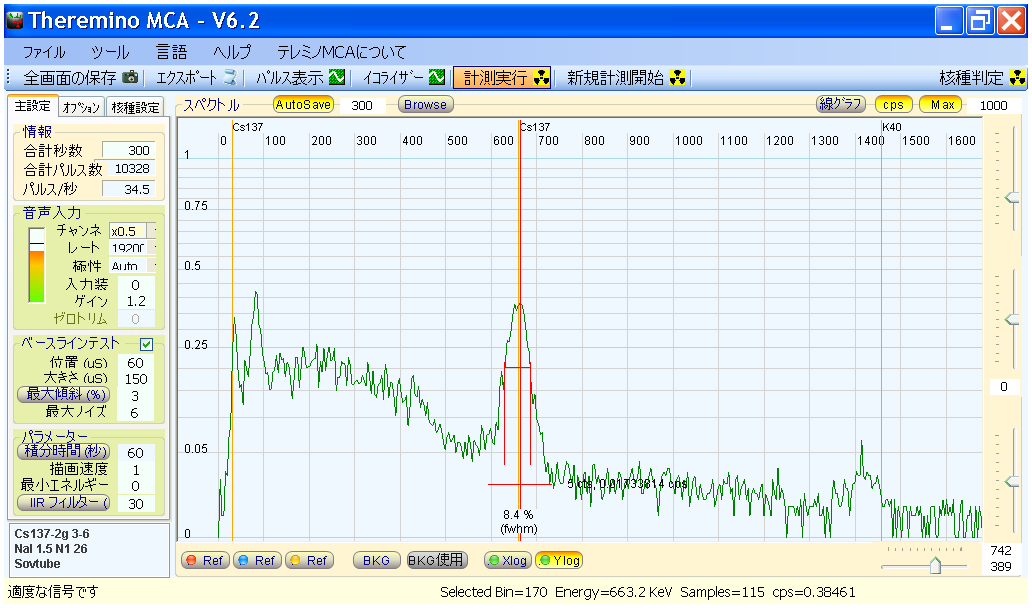
http://pico.dreamhosters.com/img/V60/2013_12_10_07_56_43-Cs137-2g_3-6-NaI_1.5_N1_26.spe
http://pico.dreamhosters.com/img/V60/2013_12_10_07_56_43-Cs137-2g_3-6-NaI_1.5_N1_26.txt
28℃
室温での記録中に、灰化作戦の影響で2度ほど温度が上がり、そのせいでピークが少し左へズレた様です。
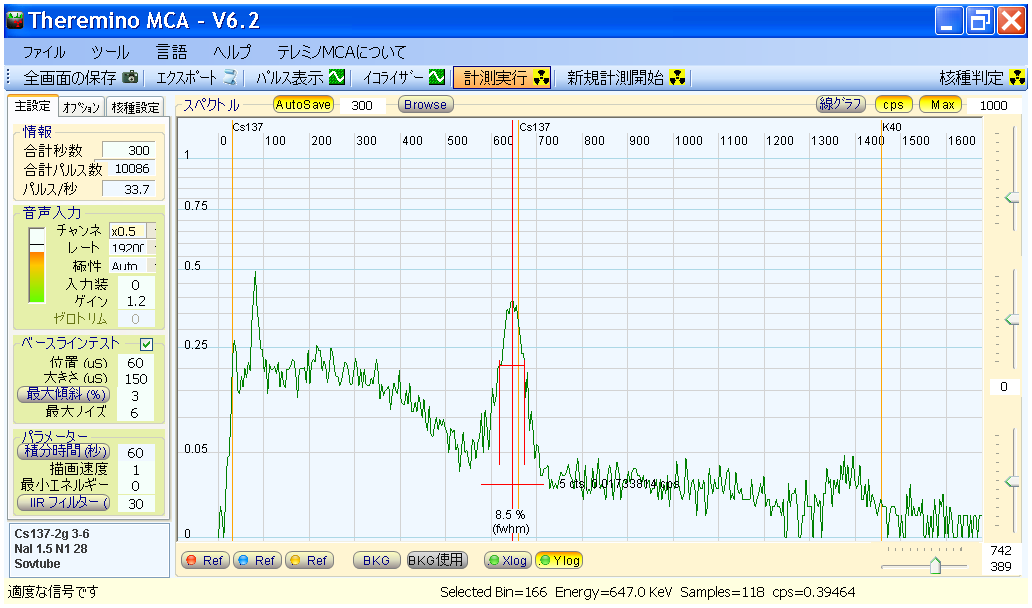
http://pico.dreamhosters.com/img/V60/2013_12_10_09_21_43-Cs137-2g_3-6-NaI_1.5_N1_28.spe
http://pico.dreamhosters.com/img/V60/2013_12_10_09_21_43-Cs137-2g_3-6-NaI_1.5_N1_28.txt
冷蔵庫に移動開始
27℃

http://pico.dreamhosters.com/img/V60/2013_12_10_09_56_43-Cs137-2g_3-6-NaI_1.5_N1_27x.spe
http://pico.dreamhosters.com/img/V60/2013_12_10_09_56_43-Cs137-2g_3-6-NaI_1.5_N1_27x.txt
21℃

http://pico.dreamhosters.com/img/V60/2013_12_10_10_01_43-Cs137-2g_3-6-NaI_1.5_N1_21x.spe
http://pico.dreamhosters.com/img/V60/2013_12_10_10_01_43-Cs137-2g_3-6-NaI_1.5_N1_21x.txt
18℃
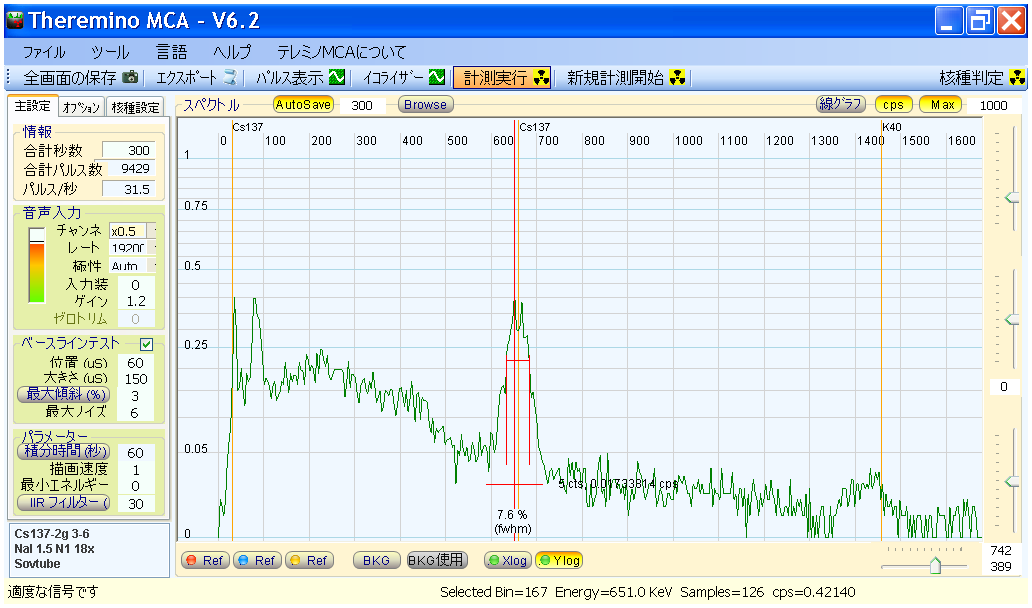
http://pico.dreamhosters.com/img/V60/2013_12_10_10_06_43-Cs137-2g_3-6-NaI_1.5_N1_18x.spe
http://pico.dreamhosters.com/img/V60/2013_12_10_10_06_43-Cs137-2g_3-6-NaI_1.5_N1_18x.txt
16℃

http://pico.dreamhosters.com/img/V60/2013_12_10_10_11_43-Cs137-2g_3-6-NaI_1.5_N1_16x.spe
http://pico.dreamhosters.com/img/V60/2013_12_10_10_11_43-Cs137-2g_3-6-NaI_1.5_N1_16x.txt
14℃
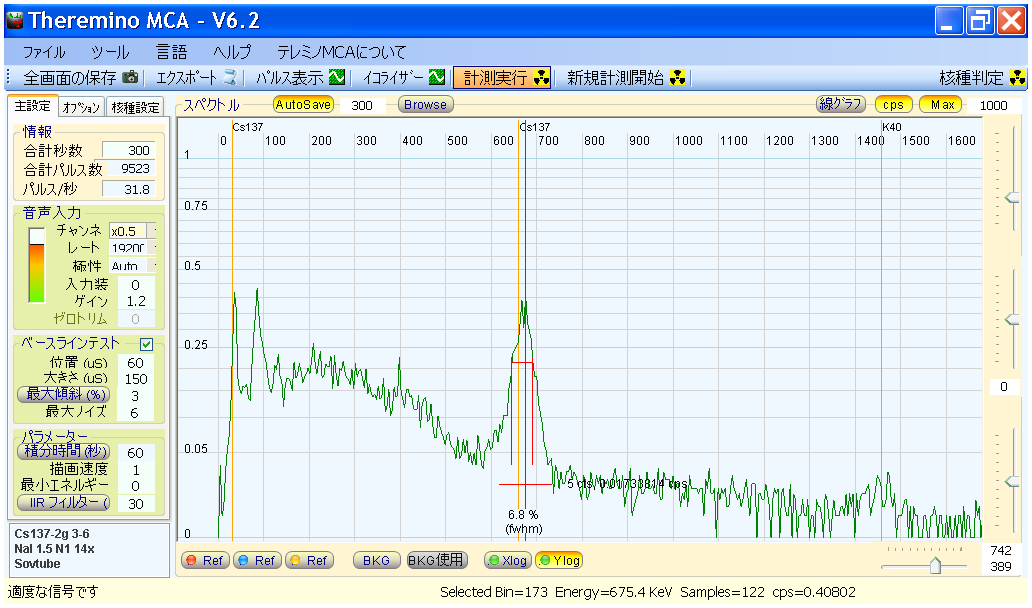
http://pico.dreamhosters.com/img/V60/2013_12_10_10_16_43-Cs137-2g_3-6-NaI_1.5_N1_14x.spe
http://pico.dreamhosters.com/img/V60/2013_12_10_10_16_43-Cs137-2g_3-6-NaI_1.5_N1_14x.txt
14℃
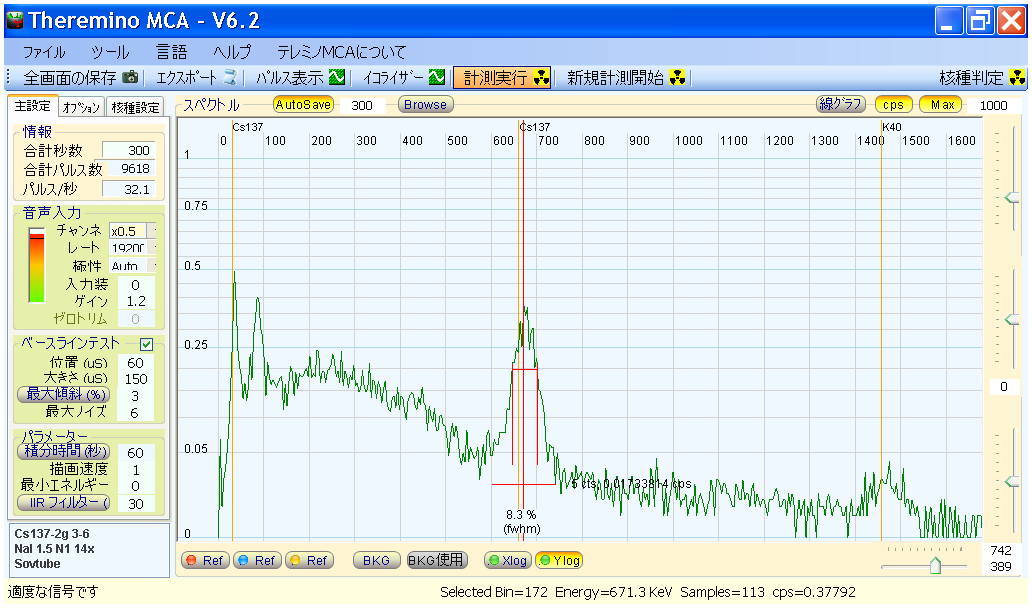
http://pico.dreamhosters.com/img/V60/2013_12_10_10_21_43-Cs137-2g_3-6-NaI_1.5_N1_14x.spe
http://pico.dreamhosters.com/img/V60/2013_12_10_10_21_43-Cs137-2g_3-6-NaI_1.5_N1_14x.txt
12℃
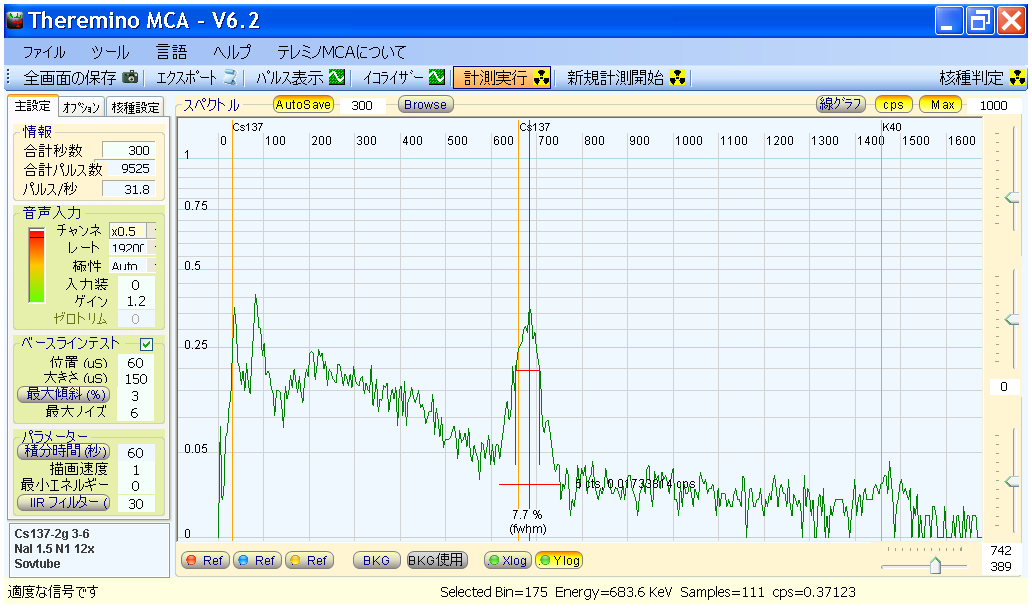
http://pico.dreamhosters.com/img/V60/2013_12_10_10_26_43-Cs137-2g_3-6-NaI_1.5_N1_12x.spe
http://pico.dreamhosters.com/img/V60/2013_12_10_10_26_43-Cs137-2g_3-6-NaI_1.5_N1_12x.txt
12℃
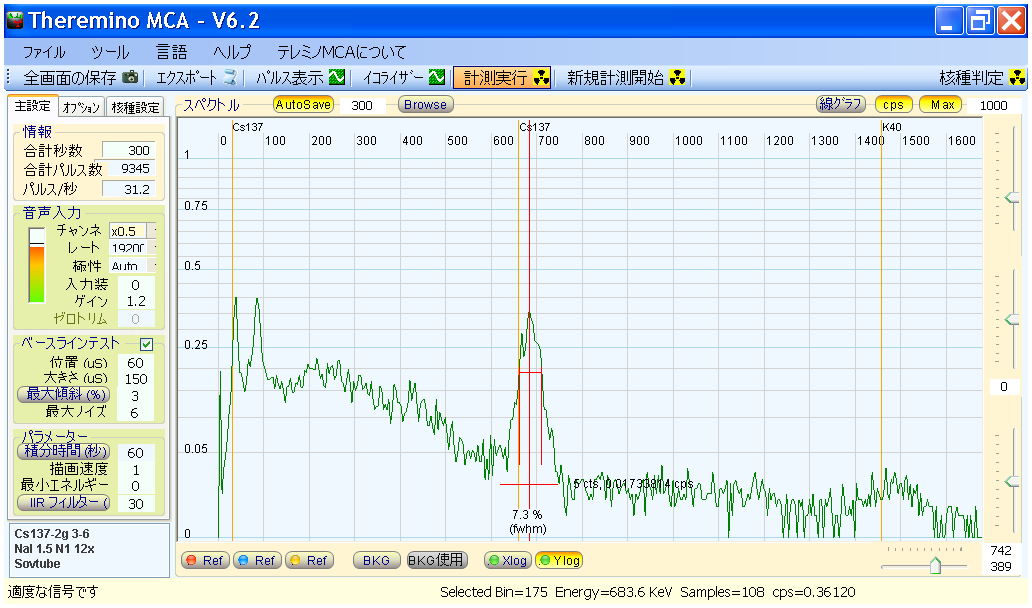
http://pico.dreamhosters.com/img/V60/2013_12_10_10_31_43-Cs137-2g_3-6-NaI_1.5_N1_12x.spe
http://pico.dreamhosters.com/img/V60/2013_12_10_10_31_43-Cs137-2g_3-6-NaI_1.5_N1_12x.txt
9℃
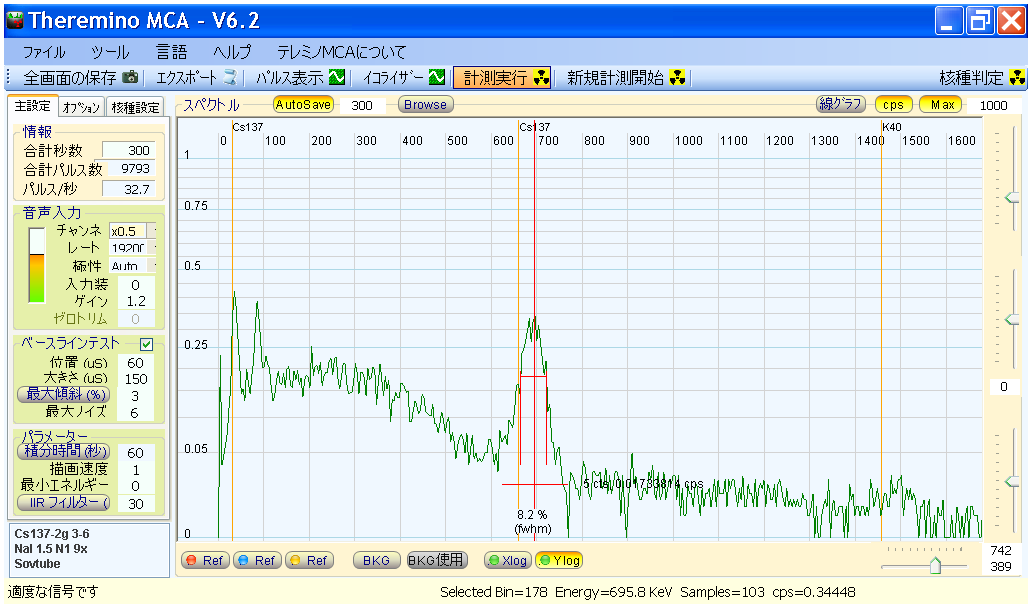
http://pico.dreamhosters.com/img/V60/2013_12_10_10_36_43-Cs137-2g_3-6-NaI_1.5_N1_9x.spe
http://pico.dreamhosters.com/img/V60/2013_12_10_10_36_43-Cs137-2g_3-6-NaI_1.5_N1_9x.txt
8℃
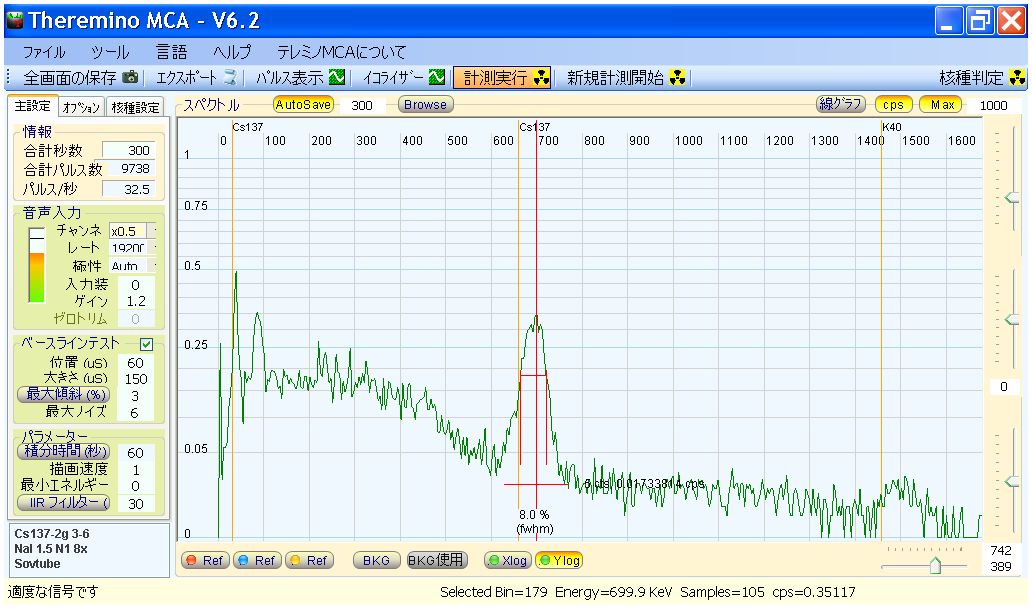
http://pico.dreamhosters.com/img/V60/2013_12_10_10_41_43-Cs137-2g_3-6-NaI_1.5_N1_8x.spe
http://pico.dreamhosters.com/img/V60/2013_12_10_10_41_43-Cs137-2g_3-6-NaI_1.5_N1_8x.txt
7℃
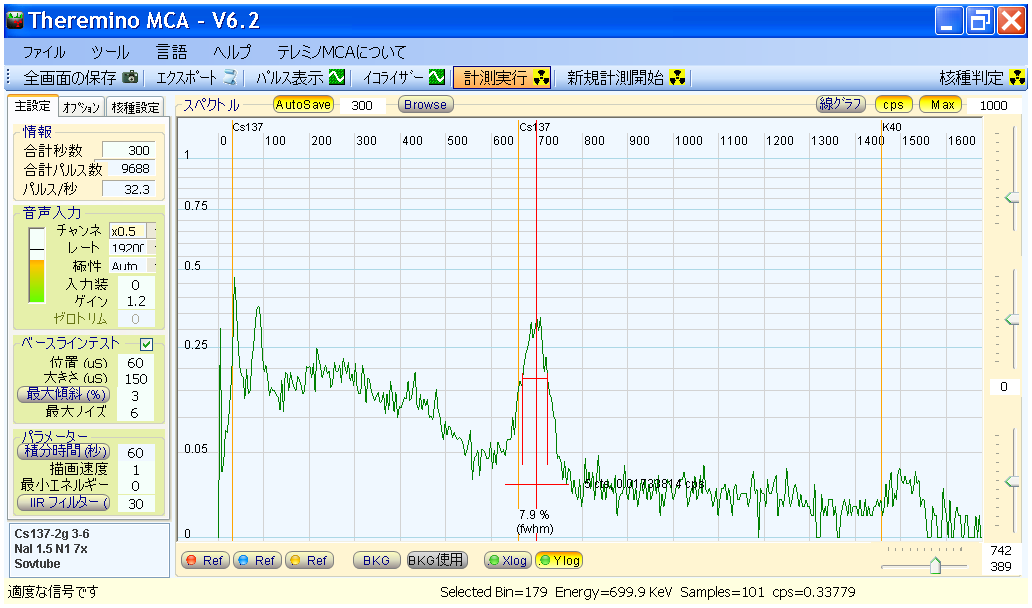
http://pico.dreamhosters.com/img/V60/2013_12_10_10_46_43-Cs137-2g_3-6-NaI_1.5_N1_7x.spe
http://pico.dreamhosters.com/img/V60/2013_12_10_10_46_43-Cs137-2g_3-6-NaI_1.5_N1_7x.txt
7℃
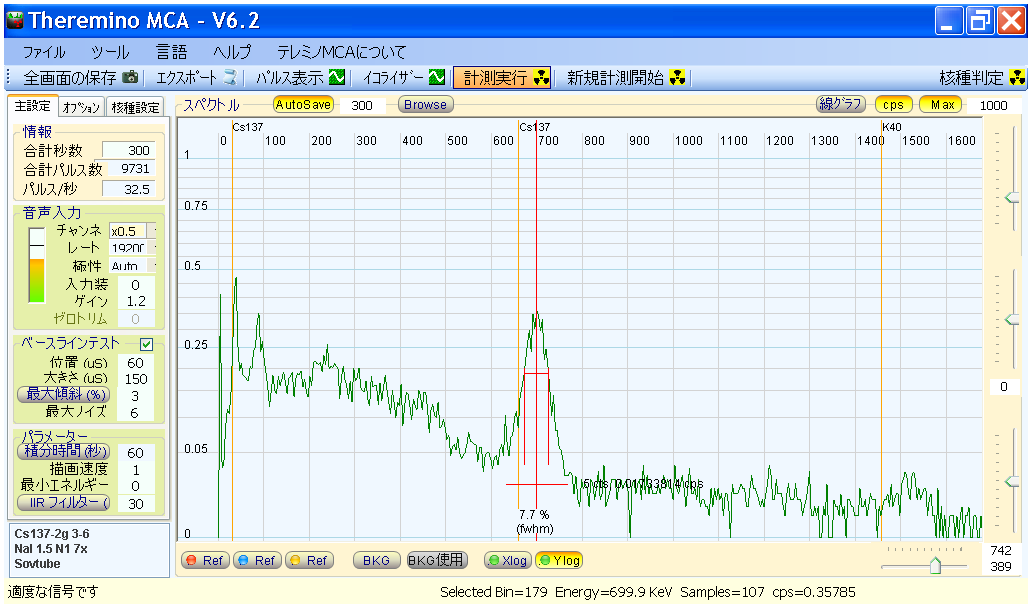
http://pico.dreamhosters.com/img/V60/2013_12_10_10_51_43-Cs137-2g_3-6-NaI_1.5_N1_7x.spe
http://pico.dreamhosters.com/img/V60/2013_12_10_10_51_43-Cs137-2g_3-6-NaI_1.5_N1_7x.txt
6℃
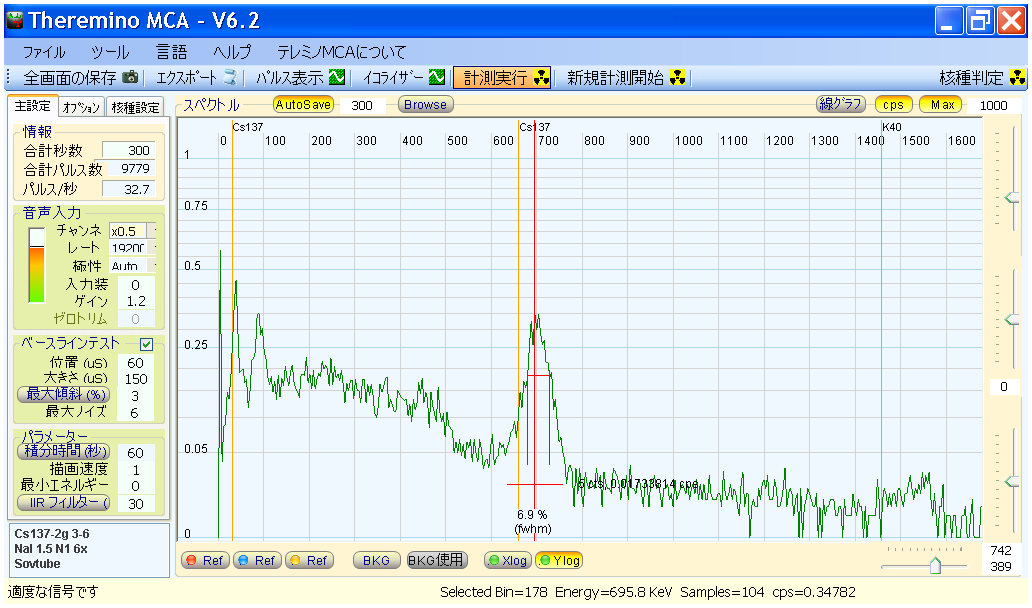
http://pico.dreamhosters.com/img/V60/2013_12_10_10_56_43-Cs137-2g_3-6-NaI_1.5_N1_6x.spe
http://pico.dreamhosters.com/img/V60/2013_12_10_10_56_43-Cs137-2g_3-6-NaI_1.5_N1_6x.txt
6℃
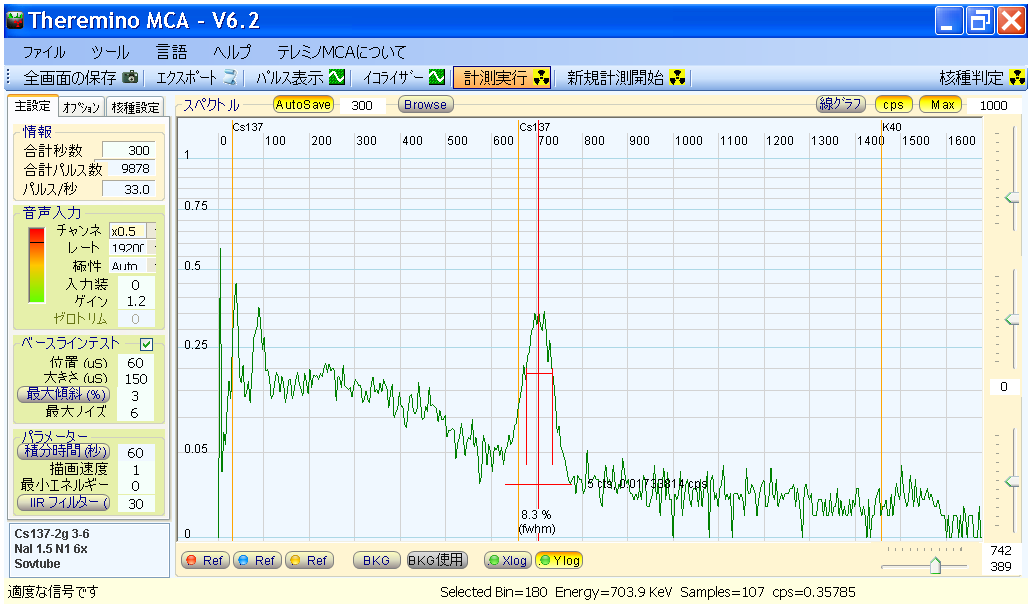
http://pico.dreamhosters.com/img/V60/2013_12_10_11_01_43-Cs137-2g_3-6-NaI_1.5_N1_6x.spe
http://pico.dreamhosters.com/img/V60/2013_12_10_11_01_43-Cs137-2g_3-6-NaI_1.5_N1_6x.txt
5℃
冷蔵庫の温度にほぼ低下完了。ただし、冷蔵庫の中の温度は、時々3.8℃と5.8℃くらいの間で揺れていました。
この様に、温度の低下とともに、ピークが右へズレ、また、一番低い方のノイズか本物のパルスが著しく増加し、
32KeVのピークも、鉛のX線よりも高くなりました。
その代わり、200KeVを中心とする丘は、温度が低下すると、若干低くなりました。
鉛のX線とCs137の662KeVのピークも若干低くなりました。
分解能については、5分ほどの測定では、定かなことは、わかりません。
The peak seems to move to the right into higher energy as the temperature drops.
The 32KeV peak became higher, too.
The plateau from Compton scatter seems to be lower.
Can't say anything about the effect on FWHM, as I didn't measure long enough.
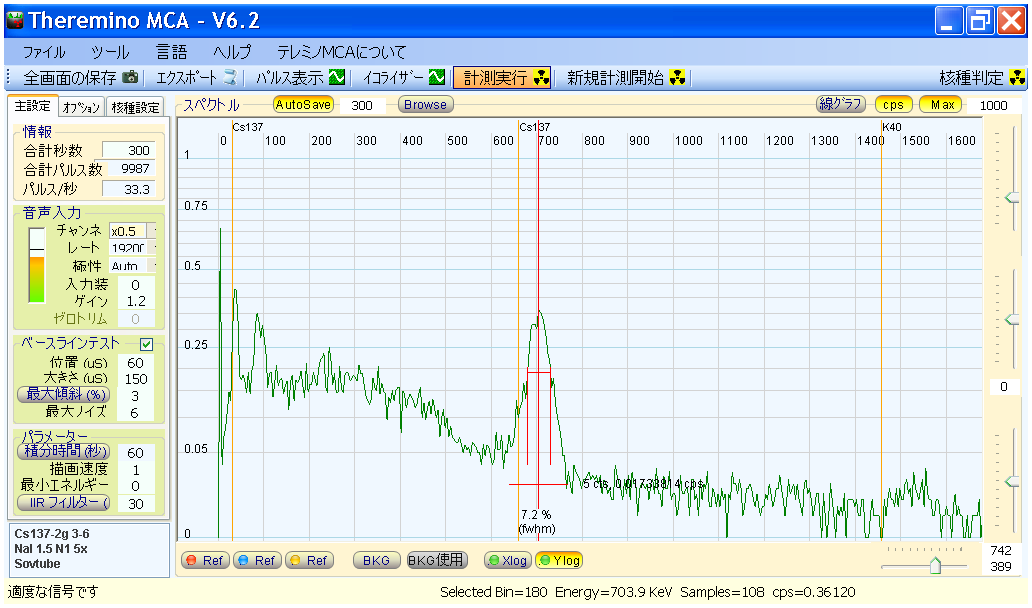
http://pico.dreamhosters.com/img/V60/2013_12_10_11_06_43-Cs137-2g_3-6-NaI_1.5_N1_5x.spe
http://pico.dreamhosters.com/img/V60/2013_12_10_11_06_43-Cs137-2g_3-6-NaI_1.5_N1_5x.txt
設定や実験方法を変えて再測定 Another trial with better configuration
上記の最初の実験が、あんまり納得がいかなかったので、設定と方法を変えて、再測定してみました。
変えて点は、まず線源として、9000Bq程度の線量がある、ディスク状の標準線源を使用して、ピークが素早く、そしてはっきりと出るようにしました。
チャンネル倍率をx2にして、もっと細かな横軸のズレが分かるようにしました。
そして、自動的保存機能の間隔を60秒にして、これもまたより細かな変化を捕らえるようにしました。
後は、スムージングをかけて、ピークの高さや位置が分かり易いようにしてあります。
まず、鉛のパイプに入れた測定器を、梱包用のプチプチで2重に包んで温度変化が少し緩やかになるようにして、冷凍庫に入れて測定します。
で、十分冷えたら、今度は、冷凍庫から取り出して、温まる様子を測定します。
テレミノMCAのノートや、スペクトルファイルに、CsI2.5とか書いてありますが、これは、変更するのを忘れた私のミスで、
使用したのは、NaIの1.5インチの1号機です。
また、Cs137の662KeVのピークが、特に左側が「ふくよか」に肥満していらっしゃるのは、今のところ謎です。
この理由を知っている方、仮説のある方は、教えて下さいね。
線量が小さな線源を使うと、こうならないので、ディスク線源を利用して線量が強いせいでこうなっているのでないかと思うのですが、
そのメカニズムとかは、まだ考えていません。
結果としては、少なくともこの測定器では、冷やすと右のエネルギーの高い方にピークは動く。
Cs137のピークは、冷やすと、もしかしたら少しだけ低くなるかも。(あんまり自信なし)
コンプトンエッジから、鉛のX線までの領域は、強いて言えば少−−−−しだけ低くなったような気もするけど、全く自信がありません。
そういうのが趣味の方は、Zipファイルにあるスペクトルデータをプロットしたりして、調べてみて下さい。
32KeVについては、冷やすと高くなる、と言っても良さそうです。
As I didn't like the result of my first attempt, I changed the configuration and tried, again.
This time, I used standard disc source of 0.25micro curie instead of 2g of soil sample so that I get the peak with better definition, quicker.
I used the Bin multiplier configuration of x2 to see finer temperature drift.
And I set
I used smoothing (IIR Filter) so that it's easier to see the drift of Cs137 peak.
First, I put the lead pipe and the detector in freezer to cool down, covered by 2 layers of plastic bags with air cushion to damper the temperature change.
Then I measured, again, as it warmed up.
Please note that the description of "CsI 2.5 N2" is my mistake as I forgot to change the note of another experiment.
I used the NaI 1.5 detector, like the first experiment.
Also, the peak of Cs137 at 662keV is somewhat fat, especially on its left side.
I do not know why it happens but I've seen this when I used this disc source and not with weaker soil samples.
Please let me know if you know the reason for this fat peak or if you have a theory.
I think we can conclude that the peak shifts to the right into higher energy, at least for this detector.
(It contains HV supply, amplifier, and USB codec for HID audio interface)
I'm not sure about what happens to the region between Compton edge and PbX.
I have an impression that this region becomes slightly lower as things cool down, but it's not very visible.
Other than that, the peak for 32keV seem to be higher as the temperature decreases (although the smoothing alter how it appears a lot).
23.3℃からスタート Starting at 23.3C
今回は、実験をセットして、寝てしまったので、温度は、手動で入れてないの、申し訳ありませんが分かりません。
その代わり、一時間ごとのデータを載せておきます。最終的には、マイナス11度か、それより少し低いくらいに到達したようです。
つまり、30℃くらいの温度変化によるピークの移動なので、分かりやすい結果になったと思います。(横軸の移動の方向性とかについては)
また、最後に、途中経過の全てのスペクトルや画像を入れたZipファイルも置いておくので、興味のある方は、ご覧ください。
As I just set the experiment and went to bed, there is no way to know exact temperature. Sorry.
At the end, it seems like the temperature was about -11C or even a little lower.
So,I'll show the data for each passing hour, and the zip file of all data in between for those who are curious enough to bother looking into these.
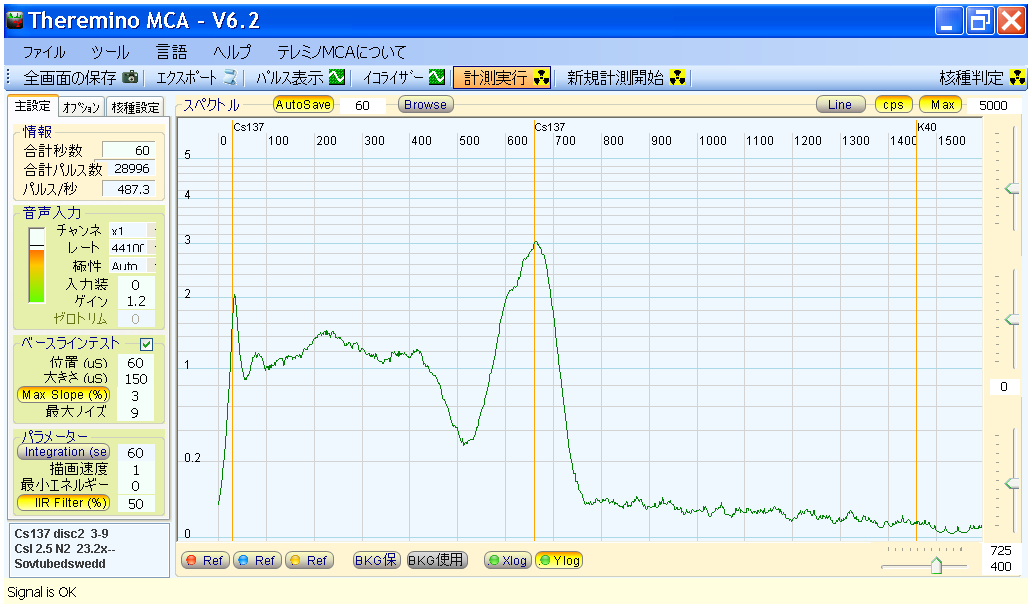
http://pico.dreamhosters.com/img/V60/2013_12_14_01_00_15-Cs137_disc2__3-9-CsI_2.5_N2__23.2x--.spe
http://pico.dreamhosters.com/img/V60/2013_12_14_01_00_15-Cs137_disc2__3-9-CsI_2.5_N2__23.2x--.txt
1時間後 After an hour
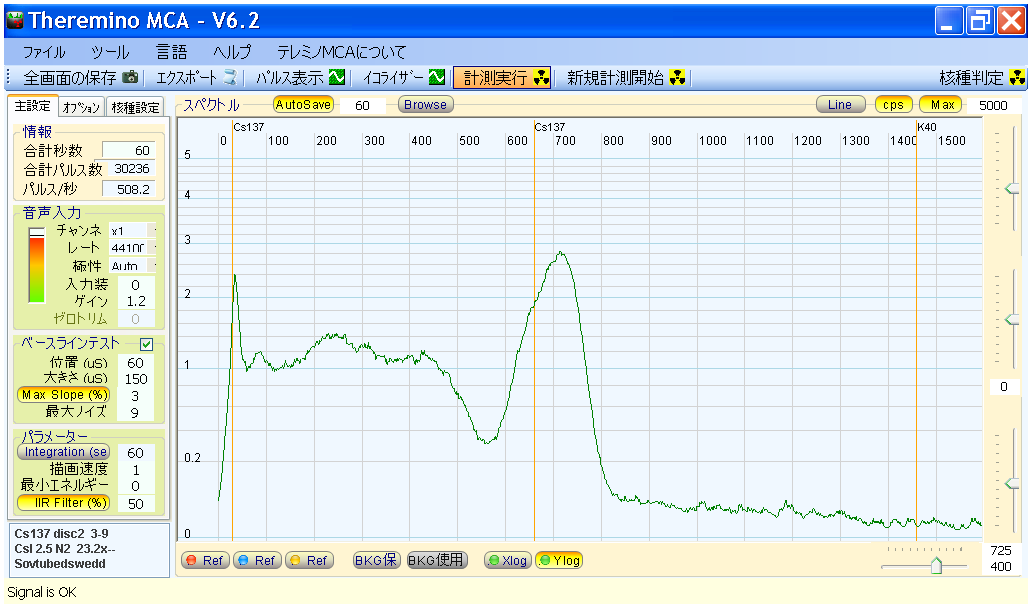
http://pico.dreamhosters.com/img/V60/2013_12_14_02_00_15-Cs137_disc2__3-9-CsI_2.5_N2__23.2x--.spe
http://pico.dreamhosters.com/img/V60/2013_12_14_02_00_15-Cs137_disc2__3-9-CsI_2.5_N2__23.2x--.txt
2時間後 After two hours

http://pico.dreamhosters.com/img/V60/2013_12_14_03_00_15-Cs137_disc2__3-9-CsI_2.5_N2__23.2x--.spe
http://pico.dreamhosters.com/img/V60/2013_12_14_03_00_15-Cs137_disc2__3-9-CsI_2.5_N2__23.2x--.txt
3時間後 After three hours
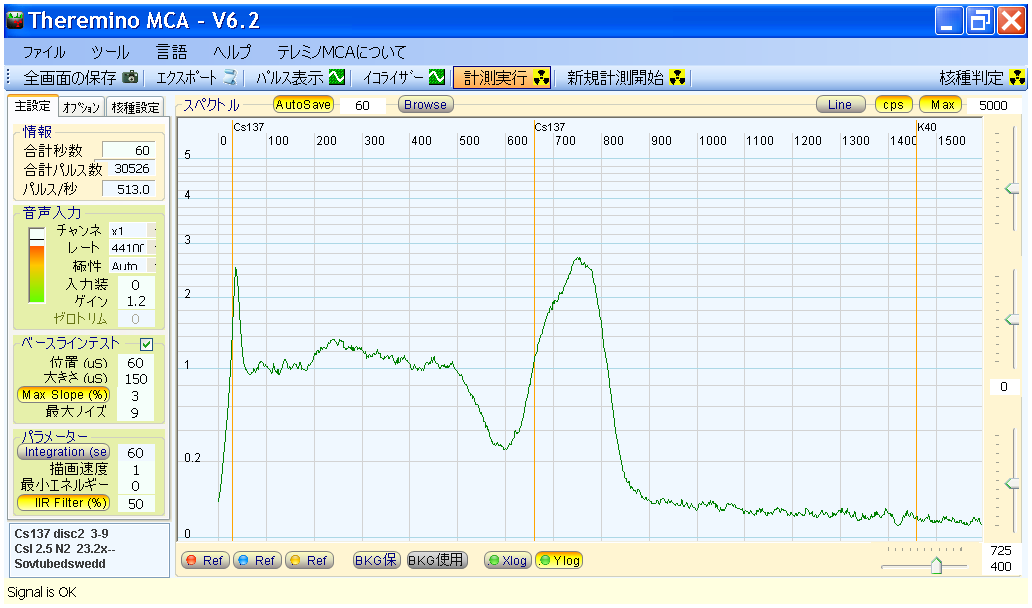
http://pico.dreamhosters.com/img/V60/2013_12_14_04_00_15-Cs137_disc2__3-9-CsI_2.5_N2__23.2x--.spe
http://pico.dreamhosters.com/img/V60/2013_12_14_04_00_15-Cs137_disc2__3-9-CsI_2.5_N2__23.2x--.txt
4時間後 After four hours

http://pico.dreamhosters.com/img/V60/2013_12_14_05_00_15-Cs137_disc2__3-9-CsI_2.5_N2__23.2x--.spe
http://pico.dreamhosters.com/img/V60/2013_12_14_05_00_15-Cs137_disc2__3-9-CsI_2.5_N2__23.2x--.txt
5時間後 After five hours
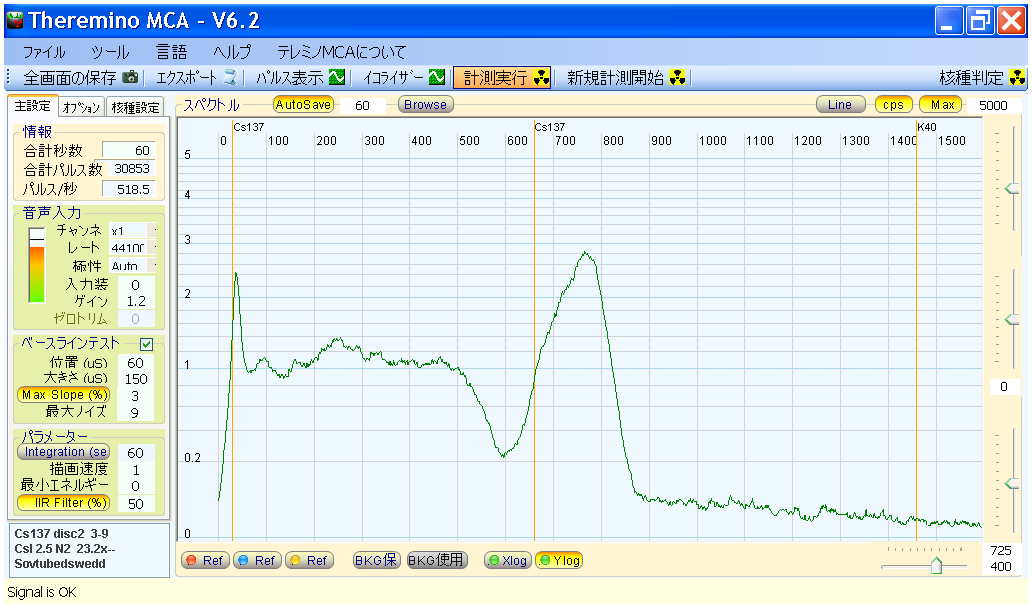
http://pico.dreamhosters.com/img/V60/2013_12_14_06_00_15-Cs137_disc2__3-9-CsI_2.5_N2__23.2x--.spe
http://pico.dreamhosters.com/img/V60/2013_12_14_06_00_15-Cs137_disc2__3-9-CsI_2.5_N2__23.2x--.txt
全データ The zip file for all data you may want to see
http://pico.dreamhosters.com/img/V60/2013_12_14_06_15_15-Cs137_disc2__3-9-CsI_2.5_N2__23.2x--.zip
しつこく、もう一回。 Yet another measurement series
もう、お分かりかと思いますが、私は個人的に納得するまで、しつこく何度も試す人なので、冷凍庫から取り出した測定器で今度は温度が上昇する様子を測定してみました。
As some of you have already noticed, I keep measuring and repeat till I get satisfied.
So, I measured again after taking out the detector as it warms up.
マイナス11℃からスタート Starting at minus 11 degree Celsius
ピークの移動がわかりやすいように、マーカーを出してみました。
温度変化は、申し訳ありませんが、あんまり記録してません。
開始14分後に、マイナス2℃になり、29分後に8.5℃、71分後に18℃、101分後に22℃、
112分後に22.4℃、120分後に22.7℃、その5分後に23.2℃で、そのまま終了
I placed a marker so that it would be easier to see the drift.

http://pico.dreamhosters.com/img/V60/2013_12_14_10_49_06-Cs137_disc2__3-9-CsI_2.5_N2__11-upx.spe
http://pico.dreamhosters.com/img/V60/2013_12_14_10_49_06-Cs137_disc2__3-9-CsI_2.5_N2__11-upx.txt
1時間後 After an hour
既に、かなり(半分以上)移動しました。温度変化は、出だしの方が時間当たりの変化量が多いので。
Already, the peak shifted more than a half. It worms up more at the beginning.
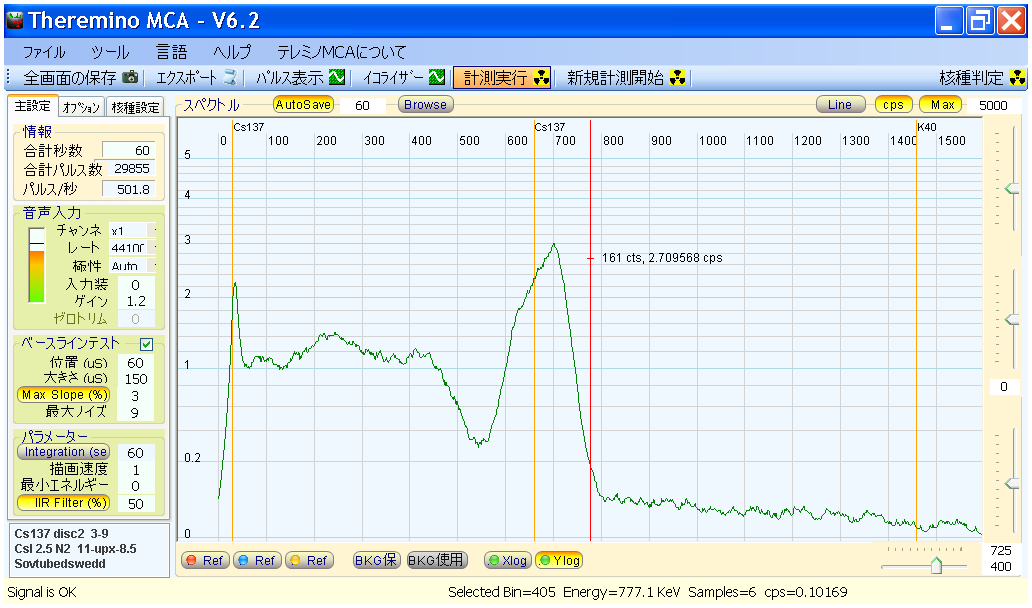
http://pico.dreamhosters.com/img/V60/2013_12_14_11_49_06-Cs137_disc2__3-9-CsI_2.5_N2__11-upx-8.5.spe
http://pico.dreamhosters.com/img/V60/2013_12_14_11_49_06-Cs137_disc2__3-9-CsI_2.5_N2__11-upx-8.5.txt
2時間後 After two hours
2時間で、ほぼ元通りになりました。
It only took 2 hours to get back to the original position.
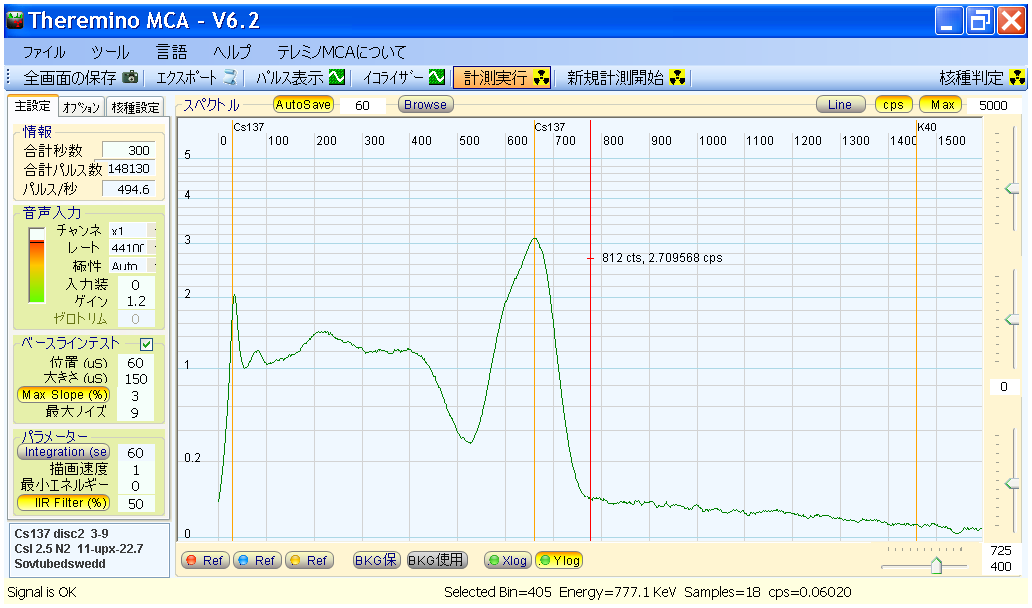
http://pico.dreamhosters.com/img/V60/2013_12_14_12_49_06-Cs137_disc2__3-9-CsI_2.5_N2__11-upx-22.7.spe
http://pico.dreamhosters.com/img/V60/2013_12_14_12_49_06-Cs137_disc2__3-9-CsI_2.5_N2__11-upx-22.7.txt
スムージングの有無をチェック Turning the smoothing on and off
水色がスムージングあり(IIRフィルター50%)。緑がなし。
The blue line is with smoothing (IIF Filter 50%). The green line is all natural.
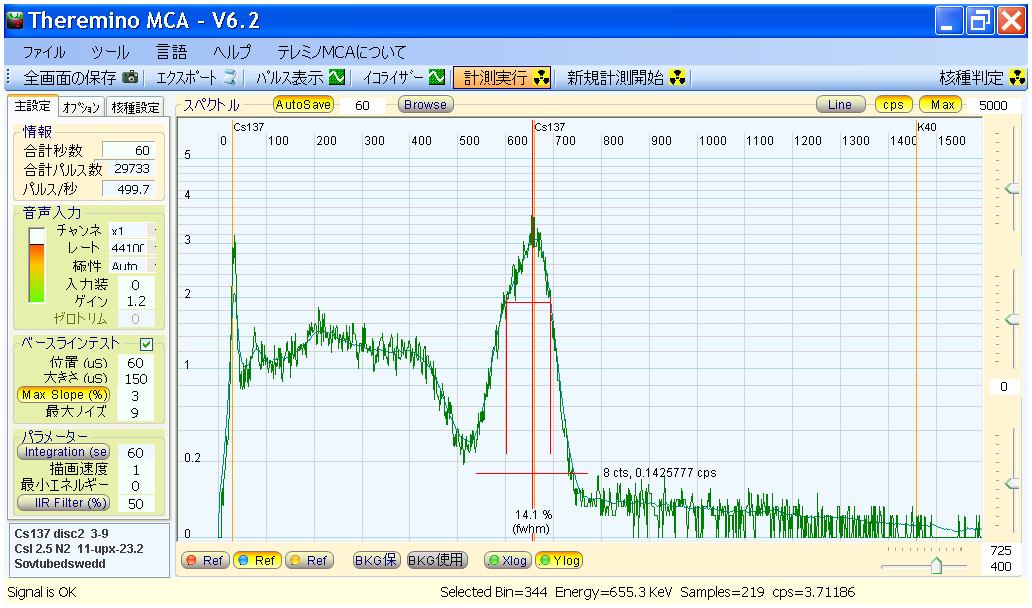
http://pico.dreamhosters.com/img/V60/2013_12_14_12_55_37-Cs137_disc2__3-9-CsI_2.5_N2__11-upx-23.2.spe
http://pico.dreamhosters.com/img/V60/2013_12_14_12_55_37-Cs137_disc2__3-9-CsI_2.5_N2__11-upx-23.2.txt
600秒測ると、こんな感じ。 If I measure 600 seconds, it becomes smoother like this
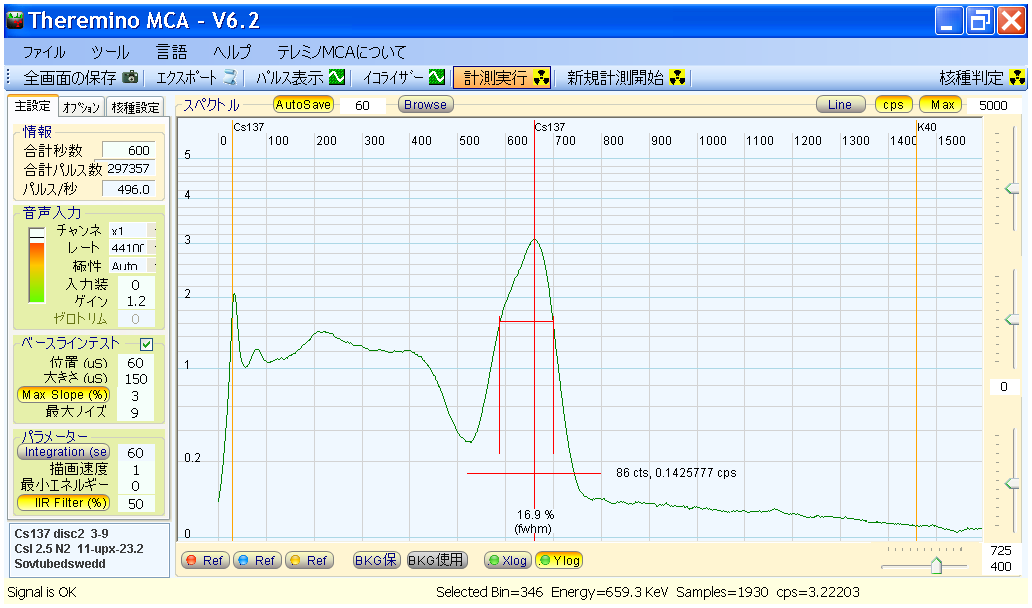
http://pico.dreamhosters.com/img/V60/2013_12_14_12_54_06-Cs137_disc2__3-9-CsI_2.5_N2__11-upx-23.2.spe
http://pico.dreamhosters.com/img/V60/2013_12_14_12_54_06-Cs137_disc2__3-9-CsI_2.5_N2__11-upx-23.2.txt
32KeVの様子 Seeing more closely into the 32keV peak
X軸(横軸)も対数表示にして、低いほうを引き伸ばし、32KeVが少し見やすくなるようにして、FWHMの表示もさせてみました。
ただし、この数値とかは、あんまり正確ではないでしょう。
緑の線がスムージングなし。水色が50%のIIRフィルターをかけたスペクトル。
I used XLog button to better show the lower energy region.
I showed FWHM, but the number isn't necessarily very accurate.
The green line is without smoothing. The blue line is with 50% IIR filter.
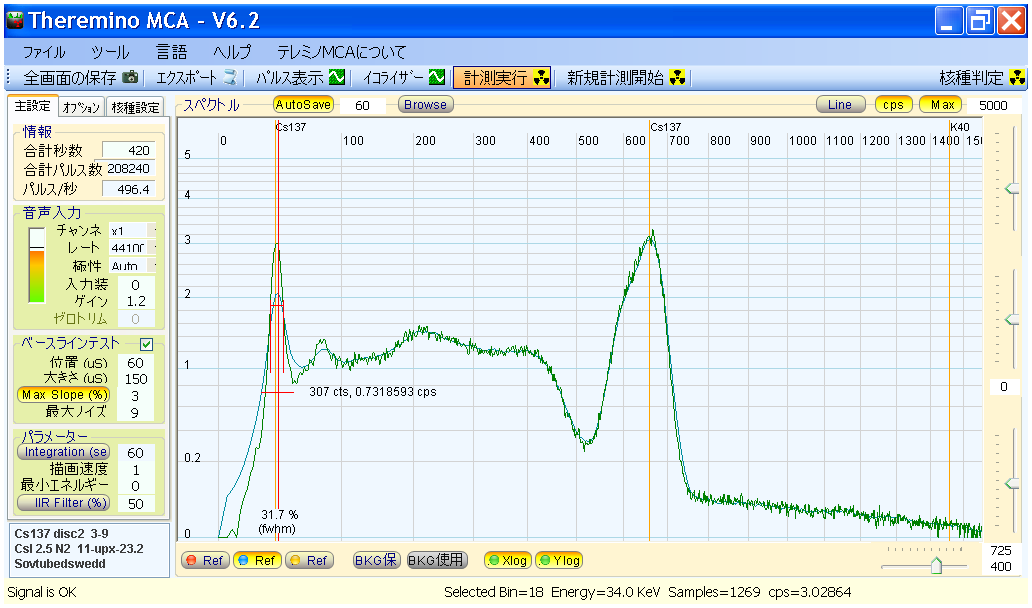
http://pico.dreamhosters.com/img/V60/2013_12_14_13_01_37-Cs137_disc2__3-9-CsI_2.5_N2__11-upx-23.2.spe
http://pico.dreamhosters.com/img/V60/2013_12_14_13_01_37-Cs137_disc2__3-9-CsI_2.5_N2__11-upx-23.2.txt
温まる様子のZipファイル Zip file of warming up process
参考文献 Documents
Temperature behavior of NaI (Tl) http://arxiv.org/ftp/physics/papers/0605/0605248.pdf Very interesting
How to counter the temperature drift http://ecad.tu-sofia.bg/et/2006/ET2006%20BOOK%202/Quantum%20and%20Nuclear%20Electronics/138%20Paper-M_Mitev.pdf
PMT (not crystal, though) http://icrc2009.uni.lodz.pl/proc/pdf/icrc0811.pdf
Temperature and Noise http://www.bnl.gov/ispo/BNLWorkshop07/Presentations/Ianakiev%20EM%20accuracy.ppt